Desideratum
Desideratum cycles were made by Hinde, Harrington & Company, who had
premises in Stewart Street and Dudley Street, Wolverhampton. The
following is a description from "Bicycles of the Year 1877" by Harry
Hewitt Griffin in which he describes a visit to the company:
"On reaching Wolverhampton, after plunging through several small makers,
it is a positive treat to reach the snug and cosy office of Messrs.
Hinde, Harrington, and Co., the young and enterprising firm.
Among the established novelties is the Safety, which has not met with
the success expected. It can certainly be put along at ten or even
twelve miles an hour by an experienced rider on it, if in good form; but
we fear it will never become popular, the chief objection being that it
is almost as unmanageable as a tricycle when moving it (leading); but
some riders will, no doubt, hail it as what was wanted, chiefly those
advanced in years: but of this more anon."
This suggests that the company was recently formed. It appears from
Harry Hewitt Griffin's book that the company had two works in 1877,
because he later mentions Desideratum Bicycle Works at 44 Dudley Street.
The following advert from 1877 gives the company's address as
Desideratum Works, Stewart Street:
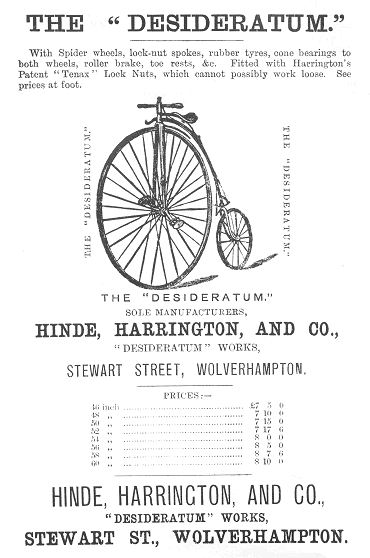
Several years later, the date is uncertain, the Stewart Street Works
were sold to Sharratt and Lisle, who by 1889 were producing the Star
Dwarf Safety Roadster there. It seems likely that Hinde Harrington and
Co. had ceased trading by 1885 because there is a description of
the Desideratum cycle in "Sturmey's Indispensable Handbook to the Safety
Bicycle, Treating of Safety Bicycles, Their Varieties, Construction &
Use" by Henry Sturmey, published in that year, in which he lists the
maker as Conway & Co. Ebury Street, Pimlico, London.
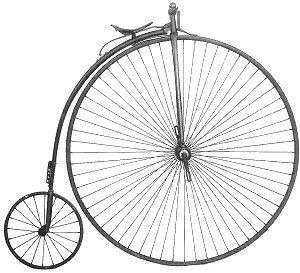
The model shown above was made c.1878, weighed 42 lbs
and had a 52" driving wheel with Brown's Aeolus bearings. The ball head
had patent inner spring self adjustment and patent adjustable rear step.
It was equipped with polished ebony hand grips. This machine is in
Glynn Stockdale's collection. The photo is by courtesy of him and
his First Penny Farthing Museum, rear of 92 King Street, Knutsford.
The following description is from
"Bicycles of the Year 1877" by Harry Hewitt Griffin:
"The Desideratum. Hinde, Harrington, and Co.,
Desideratum Bicycle Works, 44, Dudley-street, Wolverhampton. In general
construction the Desideratum offers no startling innovation, the makers
relying on the adopted and favourite types whereon to build a good
steed. In the wheels preference is given to the 'U' rim (certainly the
neatest), in which are well cemented the red (or grey) rubber tyres.
Charcoal iron wire spokes screw into gun metal or solid hubs. The
bearings (cones) are all hardened steel. The pedals are either rat-trap
or rubber clothed. Clip-toe rests are attached to the front fork. The
old socket is adhered to, though the " Stanley" head is fitted if
required. The backbone is a hollow tapering steel tube, on which the
spring, made in two forms, either to turn back (in a socket make) from
front of neck; or, with the Stanley, it is a short but elastic one,
terminating with a clip, which slides freely on the "bone." The step is
placed at a convenient distance from the ground, and at the portion of
fork best suited to bear the rider's weight; a rear wheel brake is
fitted to all. The handles, kept well down, are of ornamental wood, and
fitted on a steel bar. All machines have also a mud guard, to keep the
bicyclist's unmentionables from being soiled in wet weather. There is,
however, one great feature which of itself is sufficient to recommend
the Desideratum, we refer to Harrington's patent (No. 4315) Tenax lock
nut. The annexed cut explains the design. The nut is formed from the
best steel, and is cut through at the dark line; when the nut is off it
is almost closed, but when on the bolt it grips and binds in a splendid
manner, causing the wire in the screw to " bite" much better. By the use
of these nuts another of those manifold ills that the bicyclist is heir
to has been done away with, at least so far as the Desideratum is
concerned, for it is only on that machine that they are to be found.

A Tenax patent lock nut.
Another capital improvement is the last thing out in
brake cords, and is, I believe, a patent; it is rather a band than cord,
and consists of a narrow steel band tightly bound over with copper wire.
It is pliable, and immediate in application, and does not stretch in the
slightest. Indeed, it is impossible for it to do so, owing to its
construction. It is a great improvement on the cumbersome sash cord now
so much in use, and is rather an addition to the appearance of a
machine."
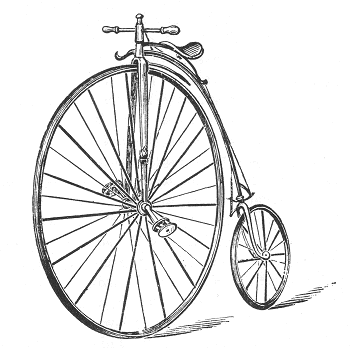
A machine from 1877.
|

A 54 inch machine. |
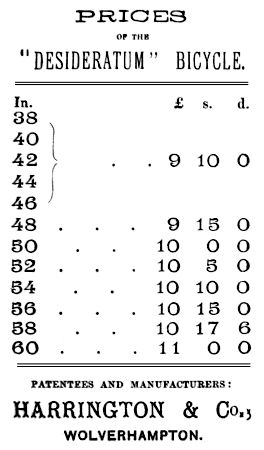 |
Joseph Devey & Co.
| Joseph Devey was one of the most successful cycle
builders during the early years of cycle manufacturing in
Wolverhampton. He was born in the town on 14th February,
1834 and baptised at St. Peter's Church on 15th November,
1834. In 1855 he married Elizabeth Anslow, also from
Wolverhampton. Sadly she died in about 1869, and on 3rd
November, 1872 Joseph married Ellen Rowland from Dudley.
Joseph Devey & Company produced a wide range
of cycles. In 1873 he started business in a small workshop
at 33 Piper's Row, Wolverhampton, at a rent
of 2s 6d. per week and rapidly expanded the business into a
large enterprise.
The early machines included the one below,
which is the Special Express. It can be seen at the
First Penny Farthing Museum, rear of 92 King Street,
Knutsford, by courtesy of whom this photo appears. The
curator, Glynn Stockdale says the machine has a 54" wheel,
weighs 49 lbs and was made about 1883. He describes
these machines as "made to a price" and says they sold well
north of the border. |
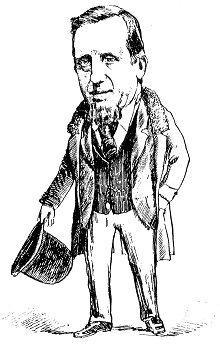
Joseph Devey. |
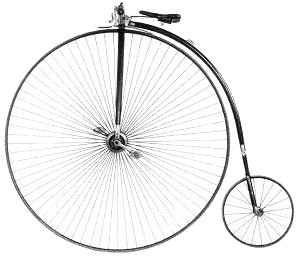
The Special Express
There were several machines in the Express
range and also machines using 'The Flyer' name. They featured lock
nutted spokes, forged hubs, a black leather saddle, bright finished
metal parts, decorative brass plates, and lubricator covers. The Express
No.1 model had refinements including a leg guard and cost an extra five
shillings.
| A short description from
"Bicycles of the Year 1877" by Harry Hewitt Griffin:
"The Wolverhampton Express. Jos. Devey, 33, Piper's Row,
Wolverhampton.
It would appear at first sight that no bicycle fit to be seen could be
built for the money, but in Wolverhampton Devey manages it otherwise,
and turns out machines that are frequently sold at almost double the
cost. Though, of course, in matters of detail the machine cannot vie
with high-class makes, still it is a wonderful production for the price
asked, and quite fit for good rough work. The "guiding power" consists
of what is commonly known as "centres," or rather a variation of that
principle, it being a cross between the old Ariel and the Tangent
method; and, being solid, is very strong. Ornamental brass plates are
attached which add to the appearance, especially as the machine is
finished all bright; the fork ends have also brass-covered lubricators.
The bearings are of hardened cones, and the motive power is applied to
either rat-trap or rubber-clothed pedals on flat slotted cranks. The
strength of the wheels is maintained by the solid forged hubs into which
the spokes are lock-nutted; angle 'V' iron rims contain the grey rubber
tyres. An easy spring slips on a hollow iron backbone. The saddle is a
novelty, being covered with black leather, and is an improvement, as a
change in appearance on the ordinary yellow pigskin.
The Wolverhampton Express No. 2. This resembles No.1, except that
it is fitted with brake, leg guard, etc., Oil can, wrench, etc., are
supplied gratis with all machines, and do not take the form of expensive
extras as in the case of some machines of treble the cost."
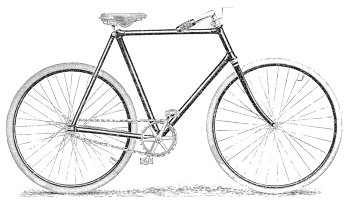 |
|
|
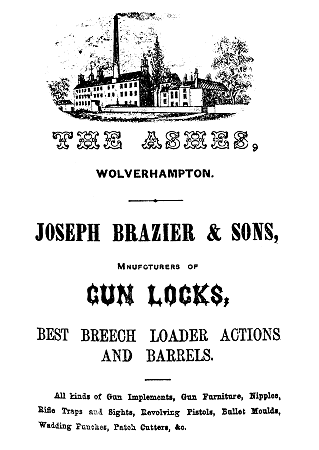
An advert from 1871. |
By the late 1870s Joseph Devey had moved into Ashes Works
(also known as Tower Works) in Pelham
Street, which had previously been occupied by gunlock
manufacturer Joseph Brazier & Sons. There was large house
and grounds on the site, which became Joseph and Ellen's home.
As well as running a successful business, Joseph was a keen
churchgoer.
|
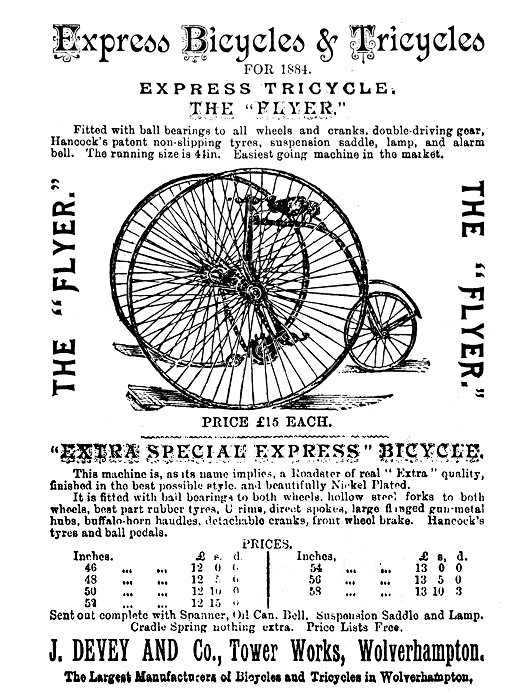
An advert from 1884.
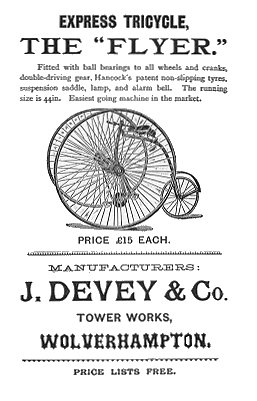 |
This advert is from the
programme for the Wolverhampton Art and Industry Exhibition of 1884. |
| In 1887 Joseph Devey sold his business to Mr. Joseph Horton
of Birmingham for £10,000. Mr. Horton also purchased the Coventry
Cycle Company Limited and Humber & Company and joined them
together to form Humber & Company Limited. On 8th March, 1900
the business became Humber Limited and production moved to
Coventry. Humber also had a factory in Great Brickkiln Street,
but this may have been the northern end of Ashes Works which
fronted onto Great Brickkiln Street.
When Joseph sold the business he continued to live in the
house next door. When production of Humber cycles was underway
it was noticed that some of the stock was regularly
disappearing. As a result the works manager and a police
constable spent a night in the factory to keep an eye on things.
They caught Joseph Devey entering the premises from his
adjoining house to steal some of the stock. He was arrested and
ended-up in prison. On his release in January 1888 he moved to
Berwick on Tweed where he founded the Northern Cycle
Manufacturing Company and produced 'Northern 'X' Cycles. |
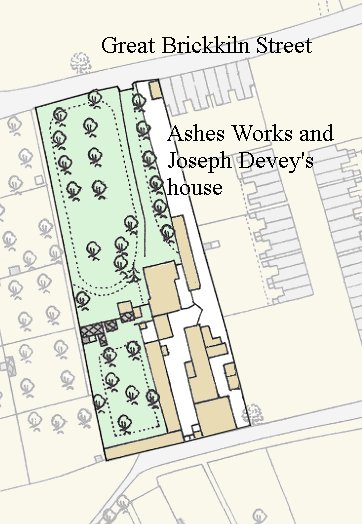 |
| When he sold his Wolverhampton business to Joseph Horton he
had to sign an exclusion clause which forbade him from producing
cycles within a 200 mile radius of Wolverhampton for a period of
time. |
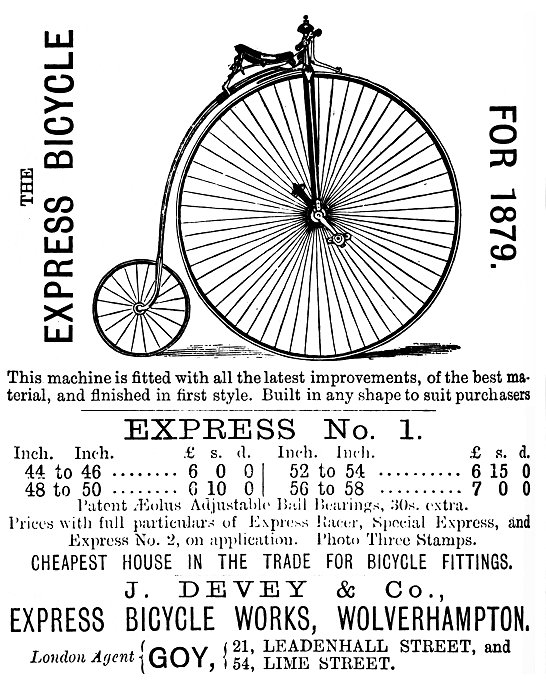
Courtesy of Jim Boulton.
|
The following description is taken
from "Sturmey's Indispensable Handbook to the Safety Bicycle, Treating
of Safety Bicycles, Their Varieties, Construction & Use" by Henry
Sturmey, published in 1885:
"Express Safety. J. Devey & Co., The Ashes,
Wolverhampton.
Description. ⅞in. and
¾in. red tyres. Crescent rims. No.
II direct spokes. 4in. G.M. hubs, 7½in.
axle. Detachable cranks, 7in. throw. Rubber coned pedals, 13in. tread.
38in. driving wheel, geared to 56in., 18in. back wheel. Front wheel
drives with chain gear. Bown's double ball bearings to crank wheels.
Morgan's chains. Set pin adjustment. Aeolus ball bearings to both
wheels. Steering like ordinary bicycle. Forks pass through bearings.
21in. rake. Hollow front and solid back forks. Stanley head, 4½in.
centres. Pear shaped horn handles, 28in. cow-horn bars. I¼in.
15 W.G. weldless steel backbone. Bolted coil spring. Suspension saddle.
Saw step. D.L.S. brake. Leg-guard. Valise, spanners, oilcan and bell.
Weight 46lbs. Price. £12.10s.0d. Sent out with bright handle-bar,
head, hubs, cranks and spokes, rest japanned in colours.
Remarks.
A sound, strong machine, at a very reasonable figure." |
|
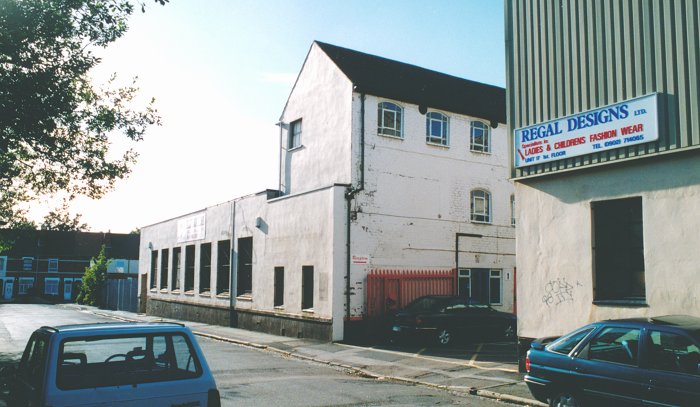
The Ashes, as seen in 2,000. It has since been
demolished.
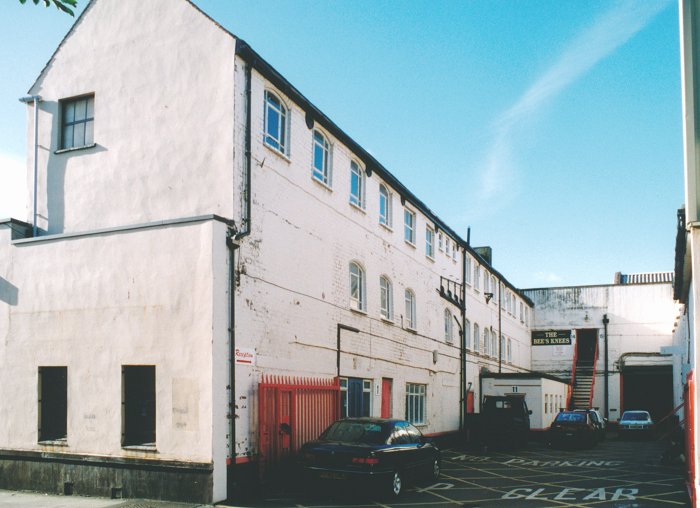
Another view of The Ashes. Also called Tower
Works.

An advert from 1886. Courtesy of Jim Boulton.
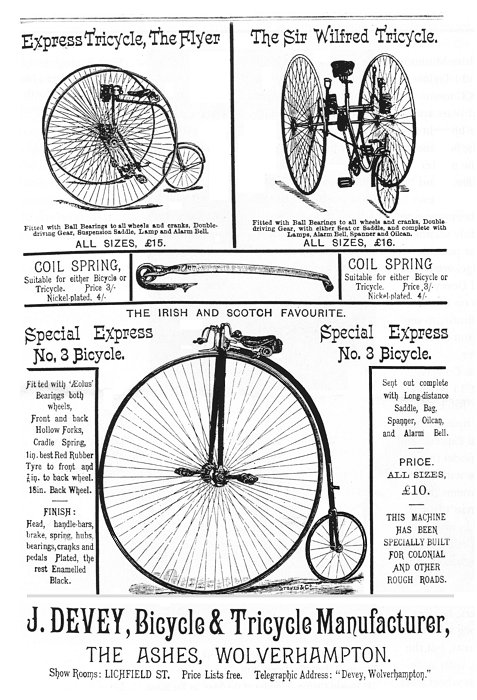
An advert from 'The Cyclist', Christmas 1885.

An advert from the 1880s.
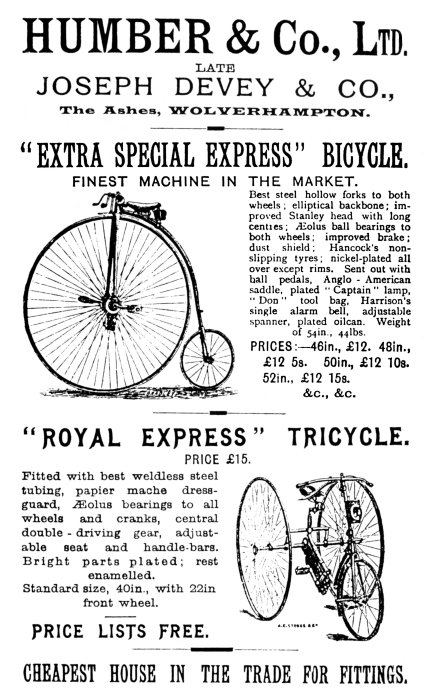
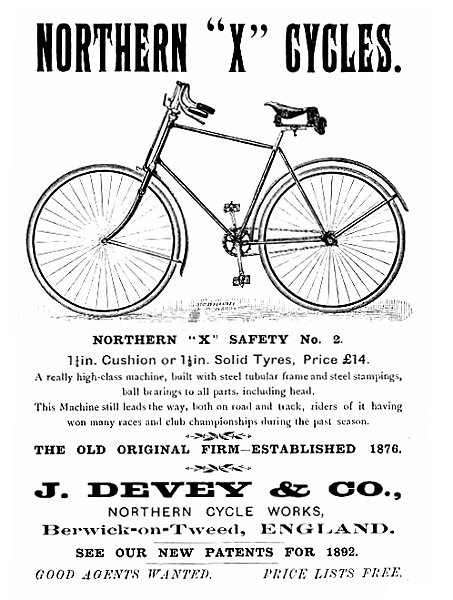
An advert from 1892.
| In 1897 Joseph Devey returned to Wolverhampton and started up
again as J. Devey & Co., in the original premises in Pipers Row. Later the company moved to Dudley Road and 47 Melbourne
Street. |
From an 1897 trade directory:
J. Devey and Go., Cycle Manufacturers, 13 Pipers Row.
The manufacture of Cycles forms one of the principal
industries of Wolverhampton, and in this connection for upwards of
twenty-two years, the firm of Messrs. J. Devey and Co. has
been prominently Associated. The are manufacturers of the celebrated
" North Express " cycles, which are widely known and appreciated
throughout the country. These machines are made of the finest
materials, whilst the construction and workmanship are of the
highest order of merit. All the latest developments in the trade
have been adopted by this firm, and there is no doubt whatever that
for lightness, strength, elegance, safety, and easiness of riding,
the "North Express" machines are unsurpassed. The showrooms, office,
and works are situated at Pipers:Row (within easy access of the
G.W.R. and L, and N.W. Railway Stations, and are well arranged and
equipped for the business. The staff of hands is efficient in
strength and skill, and the general management reflects the highest
credit upon the principal. |
|
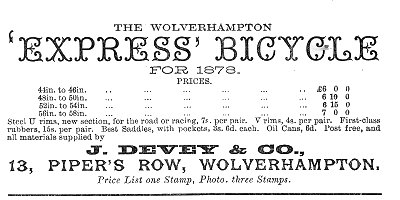
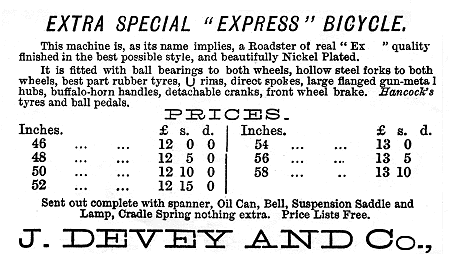
The business only survived for a few years. It went into
liquidation in 1905. The following announcement appeared in the
London Gazette on Friday 20th January, 1905:
| Debtor's name: Joseph Devey, address 14½
Dudley Road, Wolverhampton, cycle maker carrying on
business at Melbourne Works, Dudley Road,
Wolverhampton, went into liquidation on 1st
February, 1905. |
Joseph Devey died on 1st May, 1911 at the age of 77.
|
|




